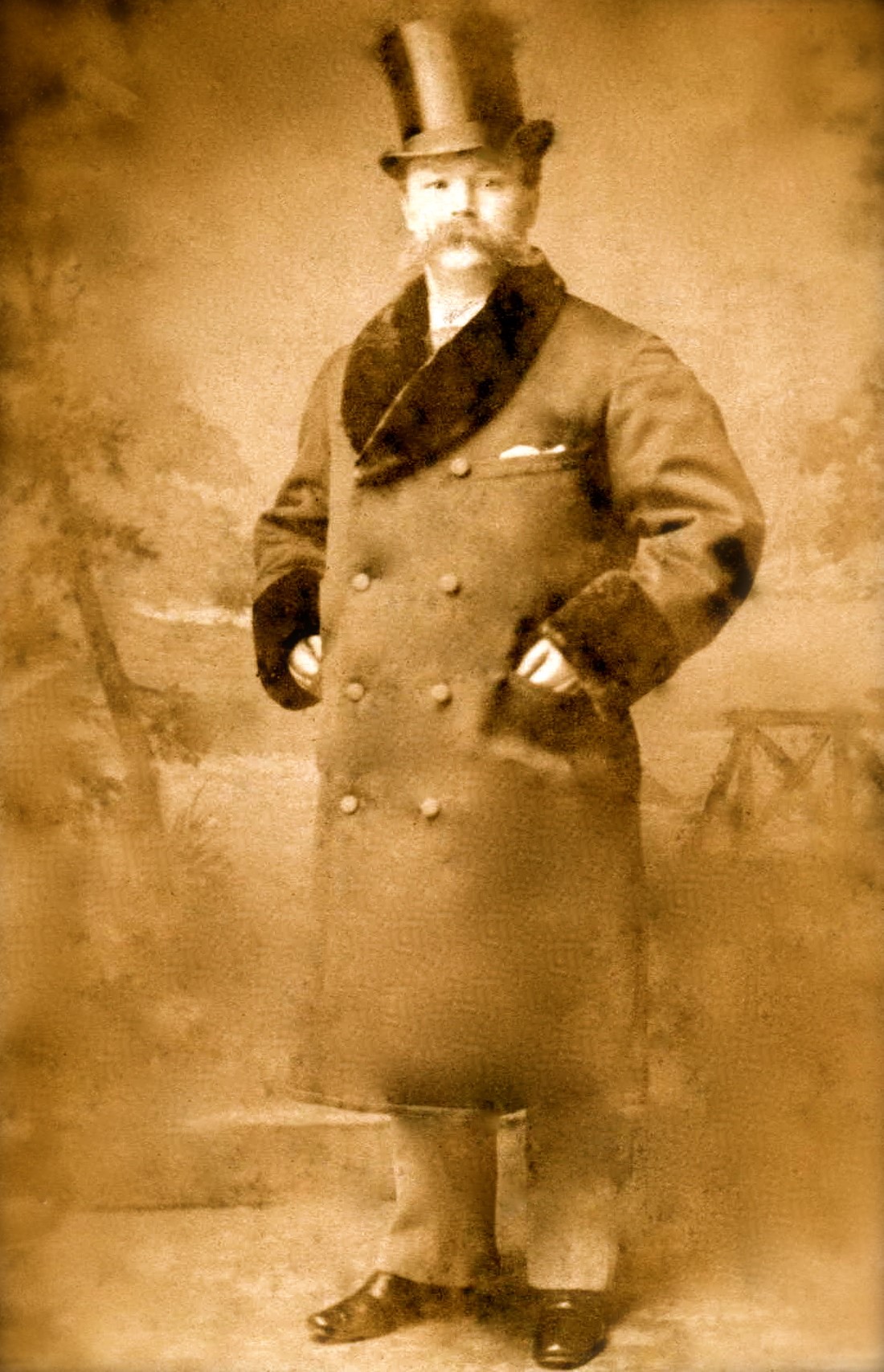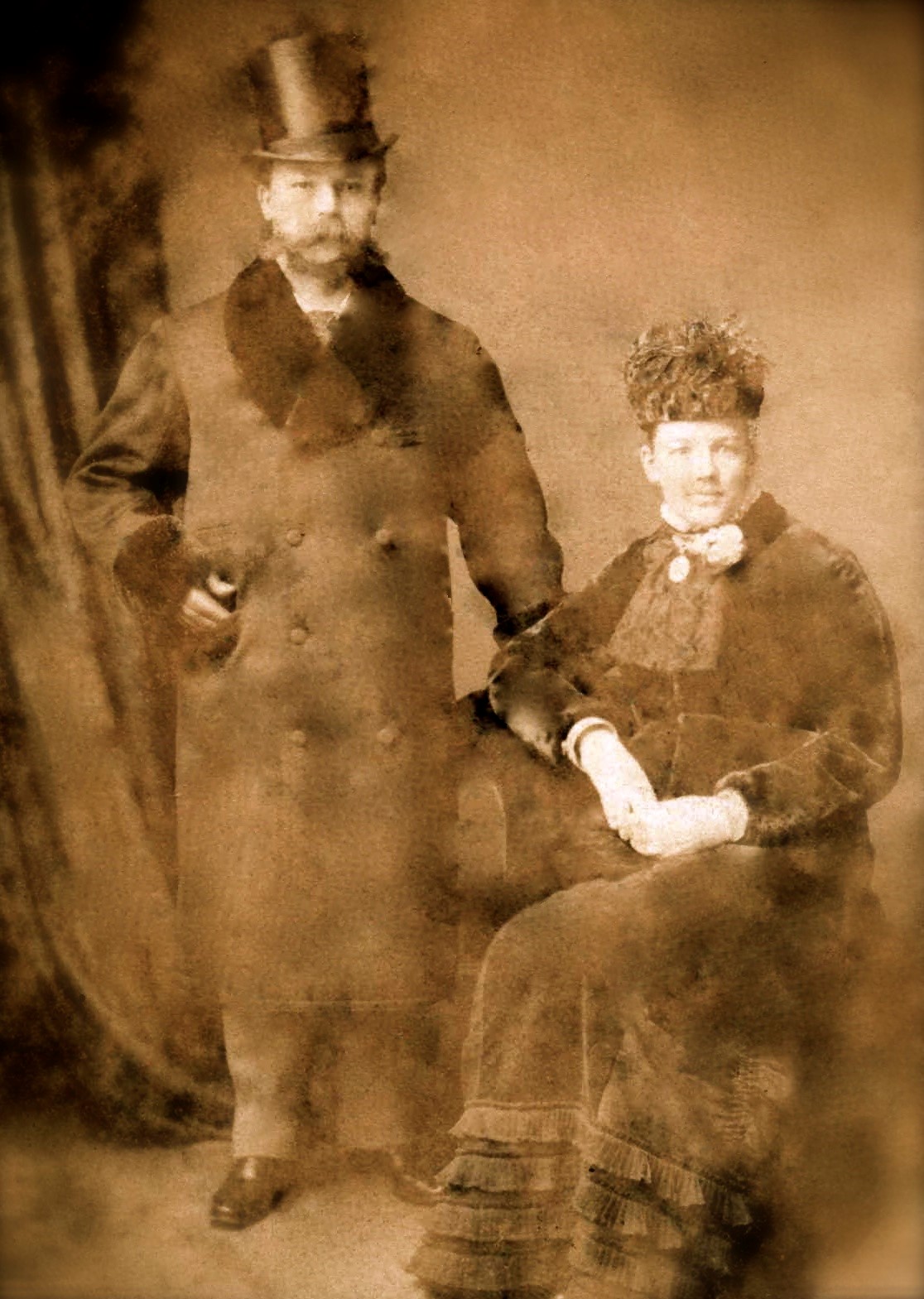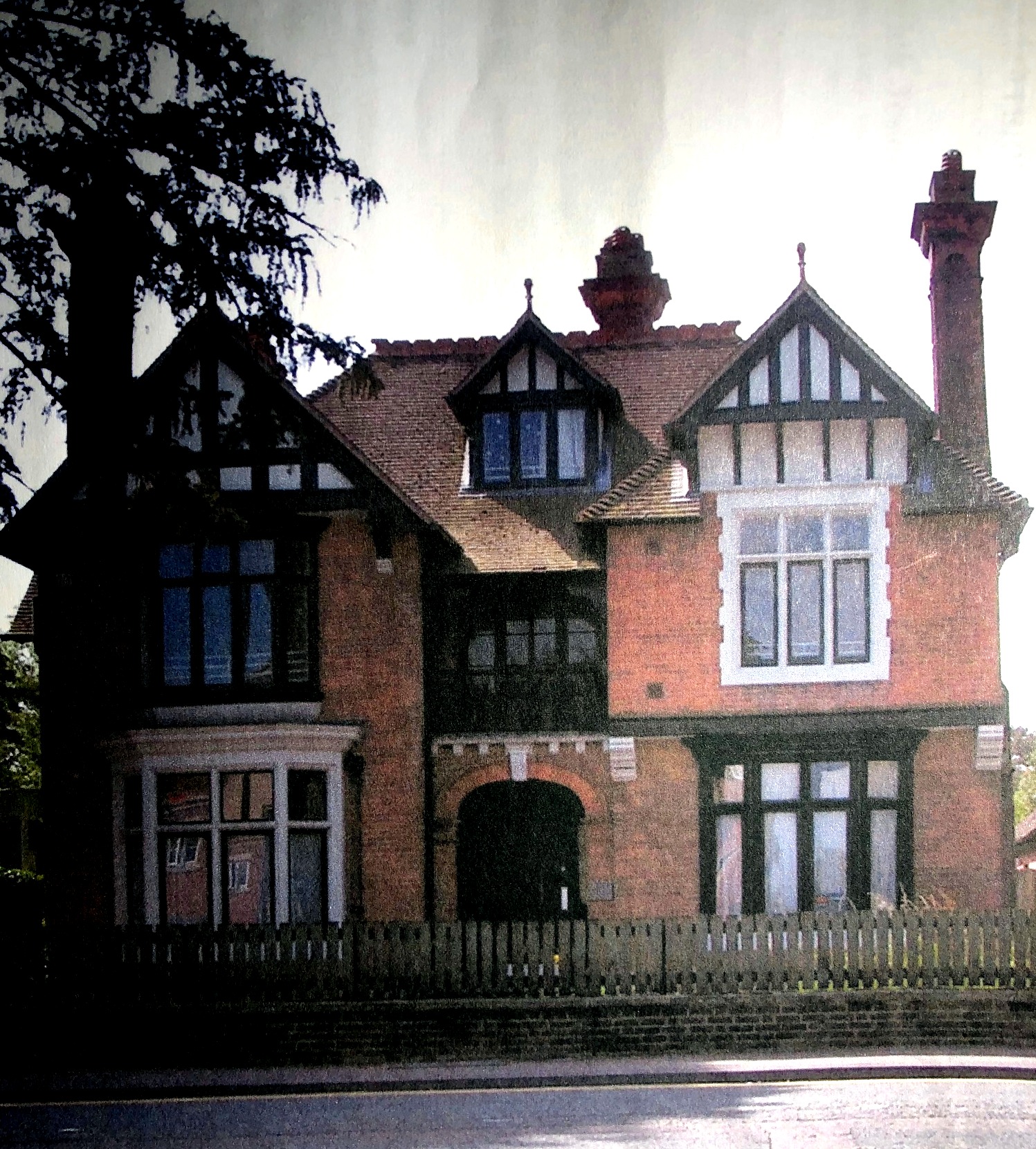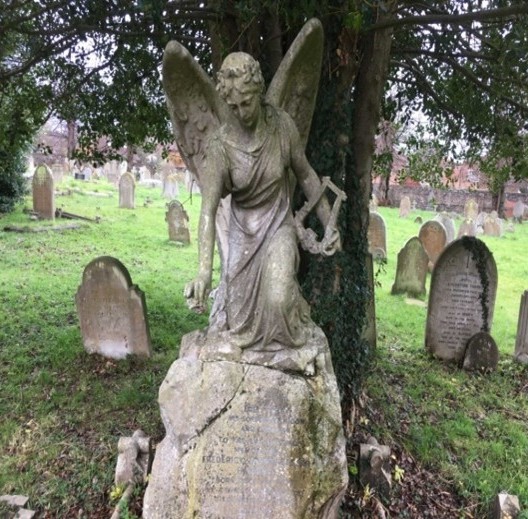
Personal Details of Frederick Joseph Jesser Harrold
| Born: | 03/12/1836 |
| Died: | 17/04/1898 |
| Buried: | 21/04/1898 |
Listed below are all the details we have been able to find so far on Frederick Joseph Jesser Harrold.
As far as we are aware, all the information is correct. However, sometimes transcriptions can lead to errors being made. If you find any errors or omissions, please let us know and we will endeavour to get them corrected as soon as possible.
If you have any further information on Frederick Joseph Jesser Harrold, we would be delighted to hear from you.
Birth
There is no information in our database regarding the birth of Frederick Joseph Jesser Harrold.
Can you help us? If so, please contact our History Research Group.
Death
There is no information in our database regarding the death of Frederick Joseph Jesser Harrold.
Can you help us? If so, please contact our History Research Group.
Burial Register
There is no burial register information available for Frederick Joseph Jesser Harrold.
Only three of the five burial register books still exist as far as we know and these are held at the Berkshire Record Office.
Stillborn children were not recorded in the burial register, only in the cemetery accounts.
Memorial Details
| From top face of base:/ Erected by his sorrowing widow and children/ to the Everlasting memory of/ Frederick Joseph Jesser Harrold/ born Dec.3rd.1836/ at Temple Wood, Wilts./ died April 17th. 1898./ Also of Jessie Aston/ died Feb.26th. 1967/ aged 76 years./ Sweetest memories of our darling sister Floral died 25th. Dec. 1935./ In Ever loving Memory of Darling Mother died 27th. Aug. 1933. | |
| Name on Memorial | Frederick Joseph Jesser HARROLD |
| Date of death | 17/04/1898 |
| Age | 62 |
| Gender | Male |
| Memorial Type | Angel with raised wings carrying lyre, resting on sculptured stone base. |
| Construction Material | Limestone |
| Condition of memorial | Fair: Inlaid letters |
| Pattison Location Code | LN13 |
| Recorder's Notes | Missing surnames from the inscriptions were taken from the burial records. |
| Others named on memorial | |
| Jessie ASTON | |
| Floral HARROLD | |
| Mary Elizabeth HARROLD |
Memorial Images
The pictures below show the memorial on which Frederick Joseph Jesser Harrold is named.
Click an image to show an enlarged version of it.
.jpg)
Harrold angel
Cemetery accounts
This information is taken from the accounts ledgers of the Newbury Cemetery Company that originally ran and maintained the cemetery.
The Ledgers are held at the Berkshire Records Office.
| Name at death | Frederick Joseph J Harrold |
| Date of burial | 21/04/1898 |
| Whence brought | Newbury |
| Where & how buried | Consecrated Brick Grave |
| By whom buried | Reverend R Dunn |
| Account Entry | Book 02 - Page 101 |
| Transcription comments | On FBMD |
Accounts Entry for Frederick Joseph Jesser Harrold
© Newbury Town Council
Reproduced with kind permission
Newspaper Cuttings
The articles below have been transcribed from newspapers and magezines.
Frederick Joseph Jesser Harrold
| Source: | Newbury Weekly News |
| Article date: | 28/04/1898 |
| Copyright: | Newbury Weekly News |
| Transciption: | THE LATE MR HARROLD The coffin was placed in the centre aisle, the Masonic deacons taking up a position on either side. The service was most impressively rendered, the hymns sung being “On the resurrection morning” and “Abide with me” and the psalm was chanted to a minor setting. As the coffin was borne from the church the “Dead March” was played. Headed by the cross-bearer, the white robed choir led the way to the Cemetery, followed by the open car, bearing the coffin covered with the flowers the deceased loved so well. Then came the carriages carrying the mourners, the Freemasons and a number of personal friends. It was quite an impressive scene, and was witnessed by hundreds of people. The interment was performed by the Vicar, and the hymn “Peace, perfect peace” was sung. Then after the sorrowing relatives had taken a last long look at the coffin as it lay in the brick grave, the Masons, following their ancient custom, filed round the grave and dropped in the sprigs of acacia which they had carried. The coffin was of polished oak, with brass furniture, and in addition to the name and age of the deceased, bore Masonic emblems inlaid with brass. The mourners were Mrs Harrold, (the widow) and her five daughters, Miss Harrold and the Misses Clark, Jessie, Florrie and Laura Harrold, Mr Harding, Mr Sidney Knight, Mr A.C.Harding, Mr C. Cumes, Mr Anthony, Mr and Mrs E.C.James, Mr A. Campbell Bazett, Dr. Burman (Ramsbury), Mr. W.T. Bilson, Nurse Jeffery, and the household servants. The Masons present including the Worshipful Master of the “Loyal Berkshire Lodge of Hope” (Bro S. Knight, jun.), preceded by the Assistant Tyler (Bro. S.P. Burton) carrying the cushion upon which rested the Bible veiled in crepe. Past Masters G. Boyer, Stephen Knight sen., W.H. Belcher, H.S. Hanington, and J. Day. Brothers Edward Gould (Mayor of Newbury), G.J. Cosburn, F.C.Fidler, A.W. Neate, J.B. Ingram, J. Rolfe, H. Salt, J.T. Hansley, J. Howard, C.H.Stradling, F.W. Goddard, W. Edmonds, J. Wright, W.H.Beames and J. Price, and Bros. J.M. Gilkes (Junior Deacon) and E. Turner (Acting Deacon). Amongst those present in church and at the graveside were Mr Councillor Hall, Mr John Parker and Mr J.W.H. Kemp (representing the Newbury Horticultural Society, Messrs J. Hiscock, W. Edwards and C. Pink, (representing Newbury Bowling Club). Messrs D.R. Jones, F.J. Coldicutt, Stanley Knight, E. Knight, E. Salway, E. Bailey, W. C. Freemantle, J. Palmer, C. Dalby, R. Bell, J.F. Haldane, Mrs E. Gould, Mr and Mrs W. Church, Mrs Day, &c. Among the floral offerings were a beautiful floral cushion from the widow; Lizzie and Clara, harp.; Flossie and Laura, anchors; Jessie, bouquet; Mr S.R. Harding, Mr and Mrs E.C. James, Mr Sidney Knight, Mr and Mrs A. Jackson and family, the Freemasons (Lodge of Hope), Newbury Bowling Club, Newbury Horticultural Society, Household servants, Mrs C. Pink, Mr and Mrs Edwards, Mrs Harding (Marlborough), Mr and Mrs Chigwidden (Swindon), Mrs G. M. Knight and family, Mr W. Miller, Mr C. Dalby, Mr and Mrs F. Hickman, Freddie and Gracie, Mr and Mrs Walter Church, Mr S. Knight, Mr and Mrs S. Knight,jun., Mr and Mrs Metcalf, Mr and Mrs Bilson (Reading). The funeral was carried out by Mr H.S. Hanington, a colleague of the deceased on the Horticultural Committee, and a brother Mason. |
GRAVE OF THE MONTH APRIL 2024 - Frederick Harrold
| Source: | Ros Clow |
| Article date: | 01/04/2024 |
| Copyright: | |
| Transciption: | Frederick Joseph Jesser Harrold - 1836 to 1898 A native of Ramsbury, he set out early in life to seek his fortune, which carried him to many parts of the world. He settled in China where he spent several years working for a steamship company. Having secured a very comfortable living he retired to Newbury in the prime of life building a handsome house in St John's Road. He named it "Kiu Kiang"* after one of the major ports on the Yangtze River. *Now "Hamley Lodge". His chief delight was Floriculture in which he excelled, as well as being an enthusiastic and efficient member of the Newbury Bowling Club. He married his sister's daughter in London and With her had five daughters. His wife and two of the daughters share the grave. He was an ardent Freemason having entered the order in Hong Kong in 1868. His return to England he joined a local Newbury Lodge, became its worshipful master and went on to receive county honours. |
| This obituary entry is awaiting verification. |
Pictures and photographs
The pictures below are all linked with Frederick Joseph Jesser Harrold.
Click an image to show an enlarged version of it.

Frederick Joseph Jesser Harrold
© Margot Wheaton

Frederick J.J. Harrold
© Margot Wheaton
.jpg)
Frederick Joseph Jesser Harrold
© General Register Office

Kui Kiang St Johns Road
©

Harrold Angel
© FNRC
Biographical Information
The articles below contain information about Frederick Joseph Jesser Harrold.
Frederick Joseph Jesser Harrold, Mason
Frederick Joseph Jesser's father was Frederick William Harrold was born 20th June 1806, his baptism is in St John the Baptist Church records at Frome. He was the son of Henry and Esther, nee Taylor, Harrold. He had brothers Henry Augustus, John who died young, James and Edmund (transported to Tasmania in 1843) and sisters Henrietta and Maria. He was an innkeeper and later wheelwright, coachmaker and landowner died in 1863 and was buried in Marlborough on 29 Dec. 1863
Frederick Joseph Jesser Harrold was born in Temple Cloud, Gloucestershire. His parents were Frederick William Harrold and Elizabeth Jesser who was born in 1808. They were married on the 19th February 1827 at St. Michael Bath. Frederick J J had 2 siblings , Lora Harrold (1831 Beckington - 1913 Marlborough) and Jesse (1838 Temple Cloud - 1882 Hong Kong)
It is interesting that both brothers went to Hong.Kong. Frederick J J became a mason at the Zetland Lodge in Hong Kong. he joined the Loyal Berkshire Lodge of Hope on 7th November 1884 (when E P Plenty was in the chair), being a member of Zetland Lodge No 525 of Hong Kong (which is still going). He went through the chair himself in 1892 in the year James Stradling (mayor in 1907) was initiatedHe became an engineer in China. (See newspaper Obits. for full Details of life.)
He retired at 44 (~1880). He married Elizabeth Harding age 26 in Covent Garden 17 Dec 1880.
NB Mary was the third of 12 children born to Henry Harding and Lora - who just happens to be the sister of Frederick J J Harrold. This makes Mary both the wife and a niece of Frederick.
Margot Wheaton has kindly provided the following additional information.
Elizabeth (Lizzie) Harrold was the eldest daughter of Frederick J J and Mary; she married Sydney Joseph Knight, a son of Mary and George Mitchell Knight (see elsewhere), Newbury’s Mayor in 1888. Sydney was a solicitor in Newbury and was very prominent in the church.
After Sydney and Lizzie married in 1901 they went to South Africa returning home to Newbury on several occasions with their 4 children
In later life the Harrolds lived on St John's Road in Newbury. Their house was called Kui Kiang, perhaps named after the port in China where Frederick worked as a marine engineer before retiring at the age of 44. Kui Kiang was famous for rice exports and opium imports!
He died on 17 April 1898 aged 61 with probate being the considerable sum of £15212 13 1d
The mayor Edward Gould attended the funeral (He too was a member of the lodge having been initiated in 1894
Author: Ros and David Clow
© FNRC
Frederick's brother Edmund transported to tasmania
Edmund HARROLD - Convict 8474
Edmund Harrold is the first recorded member of the Harrold family to arrive in Van Diemen's Land. (1)
He was born circa 1815 near Frome in the County of Somerset in Britain. His father was Henry and his mother was Esther. Brothers were Henry, Frederick and James and his sisters were Henrietta, Matilda and Minnie all of whom were living in Frome. (Court records)
Edmund paid the ultimate price when we was caught pilfering. He was tried in the Court of Petty Sessions at Wells on the 5 January 1842 for stealing and was sentenced to 10 years Transportation to Van Diemen’s Land. (2) (Wells is situated near the town of Glastonbury and slightly to the west of Frome and south of Bath).

His crime - He had stolen 4 lbs of bacon and a handkerchief. However this was not the first time Edmund had been convicted of a crime which is probably the reason for his being transported to Australia. Previous charges were for housebreaking and stealing a ring. The website convict crimes states " Laws are created to exert a moral code, sometimes to solve a problem and sometimes to help the powerful consolidate their power. These motivations can all be found in the laws that resulted in Convicts being sent to Australia". Transportation therefore was orignally seen as an alternative to the death penalty and applied to the more serious crimes but over time this changed as more workers were required to support the growing colony in Australia. This is where people like Edmund who had been convicted of theft (particulalry if it was their second offence) were also sentenced to transportation.
Edmund was transported to Van Diemen's Land on the ship the "Earl Grey" along with 264 other convicts and the 99th Regiment embarking on the 5th October 1842 at Plymouth and arriving in Australia on 14th January 1843. The ships Surgeon was Colin Arrott Browning who stated in the record of the journey that it was a "relatively fast journey of 101 days". (3) During the couse of the voyage there were seven deaths: 3 convicts and 4 children. Interestingly although a large number of people were recorded sick at various stages of the journey, Edmund does not appear on this list - evidently of good stock or of good luck.
Edmund's court records provides a good description of his apprearance being 5’6 tall, age 25, and of a dark complexion with hazel eyes. He also is described as having numerous tattoos.
Edmund spent 21 months working on a chain gang class 5 with other convicts at Bridgewater. (Of all the convicts, only 5% belonged to this group)

While serving his “time” he had his fare share of punishment for bad behavior. (Keeping in mind that convicts had nothing to lose, so to abscond was the only way out) The Hobart Prisoners Barrack Register – Register of Charges and Sentences imposed on1842-43 has a record of Edmund along with another convict (part of the Bridgewater Party) by Constable P Williams with absconding and being illegally at large until they were apprehended on 3 April 1843. The plea was “Guilty” and each was sentenced to hard labor in chains for 6 months and to be returned to their station. (4)
1806-1849 Muster provides information on the Ship he was transported on, where he was tried, the period of time, and also at that point Edmund had been hired by W. Millhouse Hobart (5) On other occassions such as 15/9/1846 he again absented himself from the Barracks without leave and was given 16 days solitary as punishment.
Between 1846 and 1852 he worked for a variety of individuals and had his Ticket of Leave refused on 30 August 1847.
An interesting assignment came in1852 when Edmund appeared be working for James Burdon in Argyle Street. According to the Hobart Mercury records, James Burdon was acoach builder which aligns with Edmund's original trade as being a "coach painter".
However, later in his record, just prior to his granting of freedom in 1854 he was charged with Larceny (under 5 pounds) and given a further 12 months hard labor.
Living in the colony Edmund was sometimes registered on official documents as either Edward or Edmund (depending on the clerk on duty that day).
After Edward (Edmund) was granted his freedom (to himself) on 30 January 1855, he entered into a “common law marriage” with Jane Page who had previously moved to Van Diemen’s land with her husband Thomas a shopkeeper. Jane Page and Edward Harrold had 30 years together and 9 children. (6)
Edward (as per record) died of paralysis which was not at all uncommon amongst convicts. They were treated dreadfully and kept in extreme cramped conditions. He died at James Street, Hobart at the age of 70 years on 27 June 1885 (7)
(1) Ancestry.com New South Wales and Tasmania, Australia Convict Musters, 1806-1849 [database on-line]. Provo, UT, USA: Ancestry.com Operations Inc, 2007. Original data: Home Office: Settlers and Convicts, New South Wales and Tasmania; (The National Archives Microfilm Publication HO10, Pieces 5, 19-20, 32-51); The National Archives of the UK (TNA), Kew, Surrey, England.
(2) Ancestry.com. Australian Convict Transportation Registers – Other Fleets & Ships, 1791-1868 [database on-line]. Provo, UT, USA: Ancestry.com Operations Inc, 2007. Original data: Home Office: Convict Transportation Registers; (The National Archives Microfilm Publication HO11); The National Archives of the UK (TNA), Kew, Surrey, England.
(3) (AUS-Tas) Surgeon's Journal "Earl Grey" arrival Hobart 14 January 1843
(5) Ancestry.com. TAHO Tasmania, Australia, Convict Court and Selected Records, 1800-1899 [database on-line]. Provo, UT, USA: Ancestry.com Operations, Inc., 2015.Original data: Tasmanian Colonial Convict, Passenger and Land Records. Various collections (30 series). Tasmanian Archive and Heritage Office, Hobart, Tasmania.
Author: D Clow
© Ken Gall
Edmund Harrold Fredericks uncle transported to Tasmania 1843
Edmund Harrold is the first recorded member of the Harrold family to arrive in Van Diemen's Land. (1)
He was born circa 1815 near Frome in the County of Somerset in Britain. His father was Henry and his mother was Esther. Brothers were Henry, Frederick and James and his sisters were Henrietta, Matilda and Minnie all of whom were living in Frome. (Court records)
Edmund paid the ultimate price when we was caught pilfering. He was tried in the Court of Petty Sessions at Wells on the 5 January 1842 for stealing and was sentenced to 10 years Transportation to Van Diemen’s Land. (2) (Wells is situated near the town of Glastonbury and slightly to the west of Frome and south of Bath).
His crime - He had stolen 4 lbs of bacon and a handkerchief. However this was not the first time Edmund had been convicted of a crime which is probably the reason for his being transported to Australia. Previous charges were for housebreaking and stealing a ring. The website convict crimes states " Laws are created to exert a moral code, sometimes to solve a problem and sometimes to help the powerful consolidate their power. These motivations can all be found in the laws that resulted in Convicts being sent to Australia". Transportation therefore was orignally seen as an alternative to the death penalty and applied to the more serious crimes but over time this changed as more workers were required to support the growing colony in Australia. This is where people like Edmund who had been convicted of theft (particulalry if it was their second offence) were also sentenced to transportation.
Edmund was transported to Van Diemen's Land on the ship the "Earl Grey" along with 264 other convicts and the 99th Regiment embarking on the 5th October 1842 at Plymouth and arriving in Australia on 14th January 1843. The ships Surgeon was Colin Arrott Browning who stated in the record of the journey that it was a "relatively fast journey of 101 days". (3) During the couse of the voyage there were seven deaths: 3 convicts and 4 children. Interestingly although a large number of people were recorded sick at various stages of the journey, Edmund does not appear on this list - evidently of good stock or of good luck.
Edmund's court records provides a good description of his apprearance being 5’6 tall, age 25, and of a dark complexion with hazel eyes. He also is described as having numerous tattoos.
Edmund spent 21 months working on a chain gang class 5 with other convicts at Bridgewater. (Of all the convicts, only 5% belonged to this group)
While serving his “time” he had his fare share of punishment for bad behavior. (Keeping in mind that convicts had nothing to lose, so to abscond was the only way out) The Hobart Prisoners Barrack Register – Register of Charges and Sentences imposed on1842-43 has a record of Edmund along with another convict (part of the Bridgewater Party) by Constable P Williams with absconding and being illegally at large until they were apprehended on 3 April 1843. The plea was “Guilty” and each was sentenced to hard labor in chains for 6 months and to be returned to their station. (4)
1806-1849 Muster provides information on the Ship he was transported on, where he was tried, the period of time, and also at that point Edmund had been hired by W. Millhouse Hobart (5) On other occassions such as 15/9/1846 he again absented himself from the Barracks without leave and was given 16 days solitary as punishment.
Between 1846 and 1852 he worked for a variety of individuals and had his Ticket of Leave refused on 30 August 1847.
An interesting assignment came in1852 when Edmund appeared be working for James Burdon in Argyle Street. According to the Hobart Mercury records, James Burdon was acoach builder which aligns with Edmund's original trade as being a "coach painter".
However, later in his record, just prior to his granting of freedom in 1854 he was charged with Larceny (under 5 pounds) and given a further 12 months hard labor.
Living in the colony Edmund was sometimes registered on official documents as either Edward or Edmund (depending on the clerk on duty that day).
After Edward (Edmund) was granted his freedom (to himself) on 30 January 1855, he entered into a “common law marriage” with Jane Page who had previously moved to Van Diemen’s land with her husband Thomas a shopkeeper. Jane Page and Edward Harrold had 30 years together and 9 children. (6)
Edward (as per record) died of paralysis which was not at all uncommon amongst convicts. They were treated dreadfully and kept in extreme cramped conditions. He died at James Street, Hobart at the age of 70 years on 27 June 1885 (7)
(1) Ancestry.com New South Wales and Tasmania, Australia Convict Musters, 1806-1849 [database on-line]. Provo, UT, USA: Ancestry.com Operations Inc, 2007. Original data: Home Office: Settlers and Convicts, New South Wales and Tasmania; (The National Archives Microfilm Publication HO10, Pieces 5, 19-20, 32-51); The National Archives of the UK (TNA), Kew, Surrey, England.
(2) Ancestry.com. Australian Convict Transportation Registers – Other Fleets & Ships, 1791-1868 [database on-line]. Provo, UT, USA: Ancestry.com Operations Inc, 2007. Original data: Home Office: Convict Transportation Registers; (The National Archives Microfilm Publication HO11); The National Archives of the UK (TNA), Kew, Surrey, England.
(3) (AUS-Tas) Surgeon's Journal "Earl Grey" arrival Hobart 14 January 1843
(5) Ancestry.com. TAHO Tasmania, Australia, Convict Court and Selected Records, 1800-1899 [database on-line]. Provo, UT, USA: Ancestry.com Operations, Inc., 2015.Original data: Tasmanian Colonial Convict, Passenger and Land Records. Various collections (30 series). Tasmanian Archive and Heritage Office, Hobart, Tasmania.
Author: ken gall
© ken gall
*The FNRC believe that the certificates published on this page have been added in compliance with the rules laid down by the General Register Office (GRO). Click here for more information.
If you believe that we may have inadvertently breached the privacy of a living person by publishing any document, please contact us so we can immediately remove the certificate and investigate further.
Thank you.
FNRC.
© 2010-2023. Friends of Newtown Road Cemetery, unless otherwise stated.
Web site designed by Paul Thompson
The Friends of Newtown Road Cemetery is a not-for-profit organisation that works in association with Newbury Town Council to look after and maintain Newtown Road Cemetery for the benefit of the people of Newbury.
.jpg)